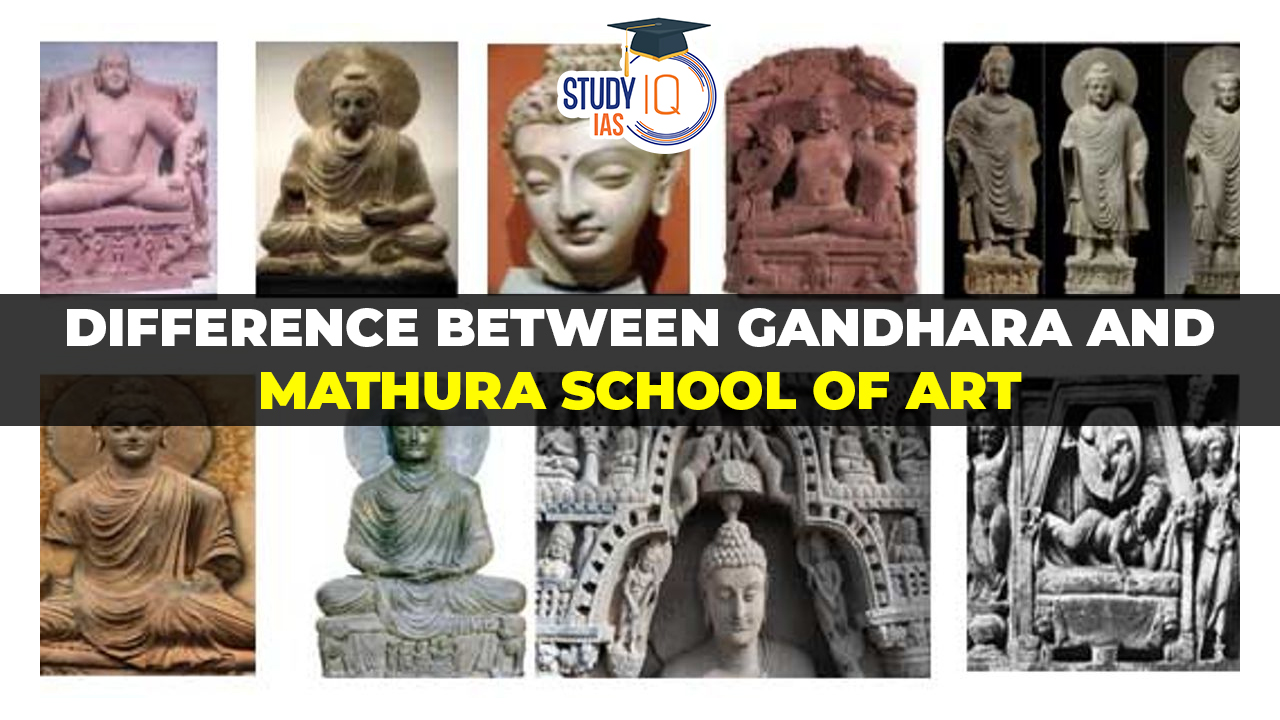Table of Contents
The Gandhara School of Art originated in what is now Peshawar and Afghanistan, situated in the western region of Punjab. It thrived between the 1st and 3rd centuries B.C. In contrast, the Mathura School of Art flourished along the banks of the Yamuna River during the same time frame. Although both art schools appeared during the Kushan rule, they were geographically distinct, with one in the Northwest Frontier (Gandhara) and the other in Mathura. This article will elucidate the fundamental distinctions between the Gandhara and Mathura Schools of Art, providing valuable insights for candidates preparing for the UPSC Civil Service examination in the context of Indian Art and Culture.
Gandhara School of Art
The Gandhara School of Art was an ancient Indian art tradition that flourished primarily in the region of Gandhara, which corresponds to parts of present-day Pakistan and Afghanistan. This art school was prominent during the 1st to 3rd centuries CE, especially under the patronage of the Kushan Empire, with its zenith under the rule of Kanishka, one of the greatest Kushan emperors. Here are some key features and characteristics of the Gandhara School of Art:
- Geographical Location: The Gandhara School of Art was centered in the region of Gandhara, which included parts of modern-day Pakistan and Afghanistan, particularly in the Peshawar Valley.
- Influences: The art of Gandhara was influenced by various cultural and artistic traditions. It notably combined elements of Indian, Greek, Roman, and Persian art, which were introduced to the region through interactions with these diverse cultures.
- Greek and Roman Influence: The Gandhara School of Art is often referred to as the “Greco-Buddhist” or “Greco-Indian” School due to its strong influence from Greek and Roman artistic styles. This influence is particularly evident in the realistic and lifelike portrayal of figures, with features reminiscent of classical Greek and Roman sculpture.
- Sculptures: Gandhara art is well-known for its intricate and detailed sculptures, especially those of the Buddha. The Buddha was depicted in a more humanized form, with clearly defined facial features and Greek-inspired drapery.
- Use of Stone: Stone, particularly gray or bluish schist, was the primary medium used in Gandhara sculptures. This material allowed for fine detailing and intricate carving.
- Narrative Panels: Gandhara art often featured narrative panels depicting scenes from the life of the Buddha, as well as Jataka tales and other religious stories.
- Combination of Religions: While Buddhist themes were prominent, the art of Gandhara also incorporated elements of Hinduism and other belief systems, reflecting the cultural diversity of the region.
- Architectural Contributions: The Gandhara School also made significant architectural contributions, with the construction of stupas and monastic complexes.
- Decline: The decline of the Gandhara School of Art is often attributed to the waning of Kushan influence in the region and the rise of other artistic traditions.
The Gandhara School of Art played a pivotal role in the development of Buddhist art in the Indian subcontinent and had a lasting impact on the artistic and cultural heritage of the region. Its unique blend of influences and the lifelike portrayal of figures make it a fascinating chapter in the history of Indian art.
Mathura School of Art
The Mathura School of Art was an ancient Indian art tradition that thrived in the city of Mathura, located along the banks of the Yamuna River, during the 1st to 3rd centuries CE. This school of art is particularly significant for its contributions to the sculptural and artistic heritage of India. Here are some key characteristics and features of the Mathura School of Art:
- Geographical Location: The Mathura School of Art was centered in the city of Mathura, in what is now the Indian state of Uttar Pradesh. Mathura is considered a sacred city in Hinduism and is associated with the birthplace of Lord Krishna.
- Indian Influence: The Mathura School of Art was deeply rooted in Indian culture and spirituality. It was characterized by a strong connection to Indian traditions, religious themes, and iconography.
- Material and Sculpture: Red sandstone was the primary material used for sculpting in the Mathura School. The sculptures were typically carved in this soft, locally available stone, allowing for intricate detailing.
- Spirituality and Iconography: Mathura sculptures often depicted religious and mythological themes, including representations of gods, goddesses, and mythological narratives. The art from Mathura emphasized the spiritual and divine aspects of these subjects.
- Buddhist and Hindu Themes: The Mathura School of Art produced sculptures of various deities and themes, including representations of Buddha and Bodhisattvas, as well as Hindu deities such as Vishnu, Shiva, and various goddesses.
- Iconic Forms: In contrast to the Gandhara School, the Mathura School of Art portrayed deities and figures in a more traditional and iconic manner, with a focus on spirituality rather than naturalistic details.
- Jain Influence: The Mathura School also created sculptures related to Jainism, particularly Tirthankaras, reflecting the religious diversity of the region.
- Narrative and Influence: The sculptures of the Mathura School had a profound influence on the narratives and artistic depictions in major Indian religions of the time, including Hinduism, Jainism, and Buddhism.
- Yaksha Images: Some of the artistic motifs and iconography in the Mathura School were influenced by earlier Yaksha images from the Maurya period.
The Mathura School of Art holds a special place in the history of Indian art, particularly for its dedication to indigenous artistic traditions, spirituality, and the portrayal of divine and mythological subjects. Its red sandstone sculptures continue to be celebrated for their spiritual depth and timeless artistic expressions.
Difference Between Gandhara and Mathura School of Art
The Gandhara and Mathura schools of art, both flourishing in ancient India, exhibit distinct differences in various aspects. In terms of their development, the Gandhara School emerged between 50 B.C. and 500 A.D., heavily influenced by the Indo-Greek art due to its location in the northwest Frontier, which saw interactions with Greek and Roman cultures. In contrast, the Mathura School thrived between the 1st and 3rd centuries B.C. and was largely indigenous, with minimal external influence, creating sculptures primarily inspired by Hinduism, Jainism, and Buddhism.
While the Gandhara School primarily focused on Buddhist imagery with a Greco-Roman pantheon influence, the Mathura School produced art that reflected all three major contemporary religions, leading to a more diverse array of sculptures. Materials used also differed significantly, with the Gandhara School employing bluish-grey sandstone initially and later transitioning to mud and stucco, while the Mathura School was known for its use of spotted red sandstone.
In depictions of Buddha, the two schools contrasted notably. The Gandhara School represented Buddha with flowing hair, a spiritual mood, minimal jewelry, and a reclining yogic posture, emphasizing the protuberance on his head to symbolize his omniscience. The Mathura School, on the other hand, portrayed Buddha seated in padmasana with multiple mudras and a serene expression. The head was typically shaved, and a similar protuberance was evident.
Furthermore, the Mathura School was distinctive for its emphasis on feminine figures and the portrayal of the Mother Goddess, reflecting a connection between popular religious cults and fertility. In summary, the Gandhara School was characterized by its foreign influences and a specific focus on Buddhist art, while the Mathura School remained more indigenous, diversified, and inclusive of various religious influences.
| Differences | Gandhara School | Mathura School |
| Time of Development | Between 50 B.C. and 500 A.D. | 1st to 3rd centuries B.C. |
| Patronage | Kushan dynasty | Kushan dynasty |
| Area of Development | Modern-day Kandahar region | Mathura, Sonkh, and Kankalitila |
| Influence | Heavy Greek or Hellenistic influence | Indigenous, minimal outside influence |
| Religious Influence | Predominantly Buddhist, influenced by Greco-Roman pantheon | Hinduism, Jainism, and Buddhism influenced |
| Materials Used | Bluish-grey sandstone (early), mud, and stucco (later) | Spotted red sandstone |
| Features of Buddha | Flowing hair, spiritual mood, less jewelry, reclining in yogi stance, partially closed eyes, protuberance on head | Seated in padmasana, many mudras, serene expression, shaved head, protuberance on head |
| Other Features | Depiction of the Mother Goddess and intertwining of Buddhism with fertility cults | Focus on feminine figures, beauty, delicacy, and appeal |


 Rights of Transgender Persons in India 2...
Rights of Transgender Persons in India 2...
 Climate Change Performance Index (CCPI):...
Climate Change Performance Index (CCPI):...
 BIRSA 101: India Launches World’s Most...
BIRSA 101: India Launches World’s Most...

























